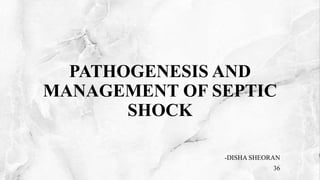
SEPTIC SHOCK- PATHOGENESIS, CLINICAL FEATURES AND MANAGEMENT.pptx
- 1. PATHOGENESIS AND MANAGEMENT OF SEPTIC SHOCK -DISHA SHEORAN 36
- 2. Shock is a systemic state of low tissue perfusion that is inadequate for normal cellular respiration which results in anaerobic metabolism and may result to cell death and multi-organ failure if perfusion is not restored.
- 3. SEPTIC SHOCK oIt results from moderate to severe sepsis or tissue damage. oIt is considered as a part of a spectrum and a progression of SIRS (Systemic Inflammatory Response Syndrome). oSepsis is life-threatening organ dysfunction caused by a dysregulated host response to infection identified by the presence of 2 or more SOFA points [Sequential (sepsis related) organ failure assessment]. oQuick SOFA (qSOFA) score is also used which has the following components- 1. Hypotension <100 mmHg 2. Tachypnea >22/minute 3. Altered mentation- GCS<13.
- 5. AETIOLOGY Gram Positive Gram negative • Clostridium tetani/welchii, Staphylococci, Streptococci and Pneumococci. • Due to exotoxins. • E. coli (most common), Klebsiella, Pseudomonas etc. • Due to endotoxins, therefore aka Endotoxic shock. • Viral, fungal and parasitic infections are rare, mostly in immunocompromised patients.
- 7. PATHOGENESIS Toxins/endotoxins from organisms like E. coli, Klebsiella Inflammation, cellular activation of macrophages, neutrophils, monocytes Release of cytokines, free radicals Chemotaxis of cells, endothelial injury, altered coagulation cascade-SIRS Reversible hyperdynamic warm stage of septic shock with fever, tachycardia, tachypnoea
- 8. Severe circulatory failure with MODS (failure of lungs, kidneys, liver, heart) with DIC Hypodynamic, irreversible cold stage of septic shock.
- 9. CLINICAL FEATURES oBased on the magnitude of infection- 1. Mild sepsis which shows fever, tachycardia, leukocytosis. 2. Severe sepsis which shows low tissue perfusion with organ dysfunction (lactic acidosis, dysfunction of liver, kidney, lungs). 3. Septic shock with systemic hypotension (BP <90 mm Hg in spite of adequate fluid therapy), severe organ dysfunction (acute lung, kidney, liver injury), maldistribution of blood flow, shunting in microcirculation. Serum lactate level is >2 mmol/L. Despite adequate resuscitation, a patient requires vasopressors to maintain MAP ~65 mmHg.
- 10. STAGES OF SEPTIC SHOCK [I] HYPERDYNAMIC (WARM) STAGE- oThis stage is reversible. o Patient is still having inflammatory response and so presents with fever, tachycardia, and tachypnoea. oPyrogenic response is still intact. oBased on blood culture, urine culture (depending on the focus of infection), higher antibiotics like third generation cephalosporins, aminoglycosides, metronidazole are started. oTreatment of the underlying cause. oVentilatory support with ICU monitoring.
- 11. [II] HYPODYNAMIC HYPOVOLEMIC SEPTIC SHOCK (COLD)- oIn this stage the pyrogenic response is lost. oPatient is in decompensated shock. oIt is an irreversible stage along with MODS (multiorgan dysfunction syndrome) with anuria, respiratory failure (cyanosis), jaundice (liver failure), cardiac depression, pulmonary oedema, hypoxia, drowsiness, eventually coma and death occurs (Irreversible stage).
- 12. TREATMENT oIt is a medical emergency therefore, patient should be shifted to the ICU (if possible). oThe aim of the treatment is- 1. Improving hemodynamic state. 2. Restore tissue perfusion thereby increasing O2 delivery to tissues. 3. Administer O2. 4. Combat the bacteria and cytokines. 5. Eliminate septic focus.
- 13. Volume Replacement oSecure i.v. access with 2 wide-bore cannulas and take samples for CBC, EUCr. oA crystalloid bolus of 30 mL/kg is recommended within 3 hours of detecting severe sepsis or septic shock. oA catheter is passed to empty the bladder and then monitor the hourly urine output. oVasopressor therapy is a fundamental treatment of septic shock- induced hypotension as it aims at correcting the vascular tone depression and then at improving organ perfusion pressure. Dopamine (2-20µg/min) and Nor Adrenaline (5-20µg/min) are first line vasopressors used. Terlipressin, epinephrine etc. are second line agents.
- 14. Oxygen Therapy oIn a cleared and patent airway, Oxygen is delivered via a face mask to increase Oxygen saturation. Antibiotics oLarge doses are required i.v. to combat infection. oCeftriaxone 50-100mg/kg upto 2g/day + Metronidazole 500 mg Q8H
- 15. Steroids oShort-term (one or two doses) high dose steroid therapy- single dose of methylprednisolone or dexamethasone which often may be repeated again after 4 hours is said to be effective in endotoxic shock. Treat the cause or focus oDrainage of an abscess; laparotomy for peritonitis; resection of gangrenous bowel; wound excision, peritoneal lavage etc. Pus/urine/discharge/bile/blood culture and sensitivity for antibiotics. -Activated C protein. -Monitoring the patient by pulse oximetry, cardiac status, urine output, ABG.
- 16. THANK YOU